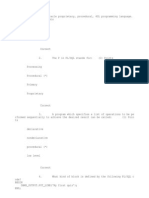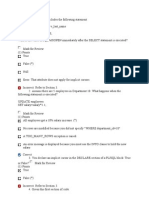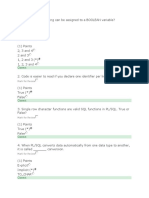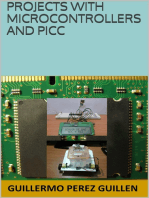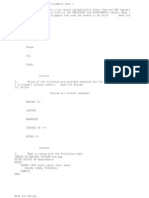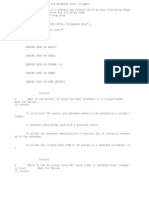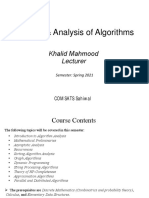Writing PL SQL Executable Statements
Uploaded by
Catalina AchimWriting PL SQL Executable Statements
Uploaded by
Catalina AchimTest: Quiz: Writing PL/SQL Executable Statements 1.
When PL/SQL converts data automatically from one data type to another, it is called _______ conversion. Mark for Review (1) Points Explicit Implicit (*) TO_CHAR
Correct 2. Which of the following data type conversions can be done implicitly? (C hoose two.) Mark for Review (1) Points (Choose all correct answers) DATE to NUMBER NUMBER to VARCHAR2 (*) NUMBER to PLS_INTEGER (*)
Incorrect. Refer to Section 2 Lesson 5. 3. Examine the following block. What should be coded at Line A? DECLARE v_char VARCHAR2(8) := '24/09/07'; v_date DATE; BEGIN v_date := ....... Line A END; Mark for Review (1) Points v_date := FROM_CHAR(v_char,'dd/mm/yy'); v_date := TO_DATE(v_char,'dd/mm/yy'); (*) v_date := v_char;
Incorrect. Refer to Section 2 Lesson 5. 4. Explicit conversions can be slower than implicit conversions. True or F alse? Mark for Review (1) Points True False (*)
Incorrect. Refer to Section 2 Lesson 5. 5. PL/SQL statements must be written on a single line. (1) Points True False (*) Mark for Review
Incorrect. Refer to Section 2 Lesson 5. 6. The LENGTH and ROUND functions can be used in PL/SQL statements. True o r False? Mark for Review (1) Points True (*) False
Correct 7. What will happen when the following code is executed? DECLARE v_new_date DATE; BEGIN v_new_date := 'Today'; DBMS_OUTPUT.PUT_LINE(v_new_date); END; Mark for Review (1) Points The block will execute and display today's date. The block will execute and display the word "Today".
The block will fail because the character value "Today" cannot be implic itly converted to a date. (*)
Correct 8. The DECODE and MAX functions can be used in PL/SQL statements. True or False? Mark for Review (1) Points True False (*)
Incorrect. Refer to Section 2 Lesson 5. 9. Using implicit conversions is good programming practice. Review (1) Points True False (*) Mark for
Correct 10. PL/SQL can implicitly convert a CHAR to a NUMBER, provided the CHAR con tains a numeric value, for example '123'. True or False? Mark for Review (1) Points True (*) False
Incorrect. Refer to Section 2 Lesson 5. 11. (1) Points Which of the following is correct? Mark for Review
v_family_name = SMITH; V_FAMILY_NAME = SMITH;
v_family_name := SMITH; v_family_name := 'SMITH'; (*)
Correct 12. Which of the following statements about implicit conversions is NOT tru e? Mark for Review (1) Points Code containing implicit conversions typically runs faster than code con taining explicit conversions. (*) Code containing implicit conversions may not work in the future if Oracl e changes the conversion rules. Code containing implicit conversions is harder to read and understand.
Incorrect. Refer to Section 2 Lesson 5. 13. The TO_CHAR function is used for explicit data type conversions. True o r False? Mark for Review (1) Points True (*) False
Incorrect. Refer to Section 2 Lesson 5. 14. Which explicit function is used to convert a character into a number? Mark for Review (1) Points TO_DATE TO_NUMBER (*) TO_CHAR
Correct
15. Examine the following code: DECLARE x VARCHAR2(20); BEGIN x:= 5 + 4 * 5 ; DBMS_OUTPUT.PUT_LINE(x); END; What value of x will be displayed? Mark for Review (1) Points 45 29 25 (*) 14
Correct ose three.) (1) Points 16. Which of the following are valid PL/SQL operators? (Cho Mark for Review (Choose all correct answers) Concatenation (*) Exception Exponential (*) Arithmetic (*)
Incorrect. Refer to Section 2 Lesson 5.
You might also like
- PLSQL Oracle Mid Term Exam Semester 1 Part 1No ratings yetPLSQL Oracle Mid Term Exam Semester 1 Part 121 pages
- Referensi PLSQL Semester 1 Mid Term ExamNo ratings yetReferensi PLSQL Semester 1 Mid Term Exam61 pages
- The Mid Term Exam For Semester 1 Is Presented To You As Two Exams0% (1)The Mid Term Exam For Semester 1 Is Presented To You As Two Exams15 pages
- PLSQL Variables - Datatype Conversion and OperatorsNo ratings yetPLSQL Variables - Datatype Conversion and Operators19 pages
- Modern C++ Programming: Including the recent standards C++11, C++17, C++20, C++23From EverandModern C++ Programming: Including the recent standards C++11, C++17, C++20, C++23No ratings yet
- DB2 11.1 for LUW: SQL Basic Training for Application DevelopersFrom EverandDB2 11.1 for LUW: SQL Basic Training for Application DevelopersNo ratings yet
- Creating DDL and Database Event TriggersNo ratings yetCreating DDL and Database Event Triggers4 pages
- Using Invoker's Rights and Autonomous TransactionsNo ratings yetUsing Invoker's Rights and Autonomous Transactions3 pages
- Assignment Int-402 Modern Web Programming: Submitted By: Nikhil Seth 10803307No ratings yetAssignment Int-402 Modern Web Programming: Submitted By: Nikhil Seth 108033076 pages
- CSC 201 Design & Analysis of Algorithms: Khalid Mahmood Lectu RerNo ratings yetCSC 201 Design & Analysis of Algorithms: Khalid Mahmood Lectu Rer43 pages
- 20 CSEC - Past Year Paper Solution 2019-2020 Sem 1 CE/CZ 1005 Digital LogicNo ratings yet20 CSEC - Past Year Paper Solution 2019-2020 Sem 1 CE/CZ 1005 Digital Logic7 pages
- How To Recover A Lost Password On A Cisco SwitchNo ratings yetHow To Recover A Lost Password On A Cisco Switch5 pages
- UNIT 1: Introduction To Information System Environment: Information Systems Analysis and DesignNo ratings yetUNIT 1: Introduction To Information System Environment: Information Systems Analysis and Design17 pages
- Everything You Can Do With Your iPhone’s Secret “Interrogation Codes”No ratings yetEverything You Can Do With Your iPhone’s Secret “Interrogation Codes”1 page
- NLD Provisioning Guidelines - OSN 9800 NetworkNo ratings yetNLD Provisioning Guidelines - OSN 9800 Network27 pages
- Lab#7: Complex Part Using G03 Ijk Input: DescriptionNo ratings yetLab#7: Complex Part Using G03 Ijk Input: Description3 pages
- SE - Unit 1 - The Process and The Product - PPTNo ratings yetSE - Unit 1 - The Process and The Product - PPT15 pages
- The Mid Term Exam For Semester 1 Is Presented To You As Two ExamsThe Mid Term Exam For Semester 1 Is Presented To You As Two Exams
- PLSQL Variables - Datatype Conversion and OperatorsPLSQL Variables - Datatype Conversion and Operators
- Modern C++ Programming: Including the recent standards C++11, C++17, C++20, C++23From EverandModern C++ Programming: Including the recent standards C++11, C++17, C++20, C++23
- DB2 11.1 for LUW: SQL Basic Training for Application DevelopersFrom EverandDB2 11.1 for LUW: SQL Basic Training for Application Developers
- Using Invoker's Rights and Autonomous TransactionsUsing Invoker's Rights and Autonomous Transactions
- Assignment Int-402 Modern Web Programming: Submitted By: Nikhil Seth 10803307Assignment Int-402 Modern Web Programming: Submitted By: Nikhil Seth 10803307
- CSC 201 Design & Analysis of Algorithms: Khalid Mahmood Lectu RerCSC 201 Design & Analysis of Algorithms: Khalid Mahmood Lectu Rer
- 20 CSEC - Past Year Paper Solution 2019-2020 Sem 1 CE/CZ 1005 Digital Logic20 CSEC - Past Year Paper Solution 2019-2020 Sem 1 CE/CZ 1005 Digital Logic
- UNIT 1: Introduction To Information System Environment: Information Systems Analysis and DesignUNIT 1: Introduction To Information System Environment: Information Systems Analysis and Design
- Everything You Can Do With Your iPhone’s Secret “Interrogation Codes”Everything You Can Do With Your iPhone’s Secret “Interrogation Codes”
- Lab#7: Complex Part Using G03 Ijk Input: DescriptionLab#7: Complex Part Using G03 Ijk Input: Description















